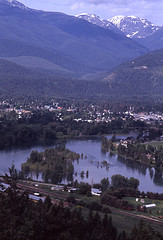
The U.S. Environmental Protection Agency yesterday declared a public health emergency in two Montana towns where hundreds of residents have developed asbestos-related diseases in the last three decades related to the operation of a vermiculite mine since the 1920s.
Although the mine, first operated by the Zonolite Co. and then W.R. Grace & Co., closed in 1990, the EPA has been investigating matters in Libby, Mont., since 1999 over concerns about vermiculite contaminated with a highly toxic and friable form of asbestos, referred to as Libby asbestos. The agency has been working with the small community to clean up contamination and address health risks. The Libby mine produced nearly 80 percent of the world’s vermiculite to use in insulation and soil. According to EPA fact sheets, the milling process at the Libby mine emitted 5,000 pounds of asbestos a day into the atmosphere. For decades, the vermiculite and vermiculite mine tailings were used throughout the small town in public places such as parks, baseball fields and school tracks. Libby asbestos is prevalent throughout Libby and Troy, Mont.
In 2002, the EPA placed Libby, and later Troy, on a National Priorities List. Hundreds of properties required cleanup and decontamination, which began in 2000 under the EPA. Despite these efforts, the EPA said, actual and potential releases of asbestos are still a significant threat to public health in Libby. Investigations performed by the Agency for Toxic Substance and Disease Registry, a division of the Centers for Disease Control and Prevention, found that from 1979 to 1998 the incidence of asbestosis, a lung condition, in the Libby area is enormously higher than the national average.
First Of Its Kind
EPA Administrator Lisa Jackson made the announcement at a press conference with Department of Health and Human Services Secretary Kathleen Sebelius and U.S. Senators Max Baucus and Jon Tester. The announcement is the first time the EPA has declared a public health emergency under the Comprehensive Environmental Response, Compensation, and Liability Act (CERCLA), which will provide greater authority to ensure further cleanup. The EPA has been conducting an average of 150 cleanups in Libby and Troy per year. The agency plans over 100 more cleanups in 2009 and is continuously providing assistance to Libby and Troy residents. There remain hundreds of homes in both town that have not yet been assessed for contamination.
A major reason for the declaration of a public health emergency is the severity and scope of asbestos contamination in Libby, making it a unique site. The EPA has identified a combination of socioeconomic, atmospheric and geographical factors allowing for widespread contamination, multiple exposure pathways and cumulative exposures. As noted by the EPA and shown in television programs on Libby, many residents insulated their homes with Libby asbestos-containing insulation and children played on waste vermiculite piles; also, many residents worked at the mine and later developed cancer and other fatal asbestos-related diseases.
The EPA is working with the Department of Health and Human Services, which has pledged additional medical monitoring and care for Libby and Troy residents.
The EPA said it has investigated several hundred sites around the country where Libby vermiculite ore was processed; 20 sites have been cleaned up. The EPA is currently looking at over 100 processing sites where 95 percent of the Libby ore was shipped. The agency notes, however, that none of the other sites present the conditions that exist in Libby because they did not involve mining. As such, the multiple pathways of exposure and concern for nearby communities does not exist at the level seen at Libby, it said.

